Traces of the 1944 Warsaw Uprising
-
Introduction

The door handle miraculously saved from the burning town hall, a blouse made out of a parachute and a watch that forever stopped on August 1… things in the Museum of Warsaw hide more than one story related to the Warsaw uprising oin1944.
A specially marked route will allow you to see the most interesting objects selected by the curators of the Museum.
Look out for the stickers with the inscription “1944” in:
Room of Warsaw Monuments, Room of Warsaw Mermaids and Room of Architectural Details (level 0)
Room of Views of Warsaw (level 1),
Room of Clothing, Room of Portraits, Room of Medals, and Room of Bronzes (level 2)
and Room of Relics (level 3).
We also recommend looking at the items near the “1944” inscription you will find at The Warsaw Data exhibition (level -1)!
-
1. Door handle from the Warsaw City Hall

Door handle and face plate with an image of the mermaid from the City Hall
Warsaw, after 1866
unknown workshop
brass, technique: casting, carving
18,8 × 9,4 × 1,5 cm (face plate); 18,8 × 9 × 7,2 cm (door handle)
MHW 20959/a-c
phot. A. Czechowski, A. NiakrasauThe door handle with the face plate originates from the Warsaw city hall – it was saved from the burning building during the 1944 uprising. The handle was rescued by a city hall janitor, and donated by his son to the Museum’s collection. A bend on one of the elements is a trace of hasty removal. It is one of the few preserved objects that formed the interior of the city hall.
The handles were cast in brass in one of the Warsaw’s workshops, probably in the second half of the 1860s, for the needs of the Magistrate edifice, which was reconstructed after a fire in 1863. The city hall was destroyed several times – it was, among other things, set on fire by participants of the January Uprising (1863-1864), who wanted to destroy the tax records stored there. The palace was destroyed again during the Warsaw Uprising of 1944 and it was not rebuild after the end of World War II. The reconstruction took place only in 1997.
The neo-Renaissance facade in the shape prior to the architectural alteration was restored only from the side of Theatre Square. The remaining facades and interiors are modern.
-
2. Teaspoon with a mermaid and a monogram Z.M.
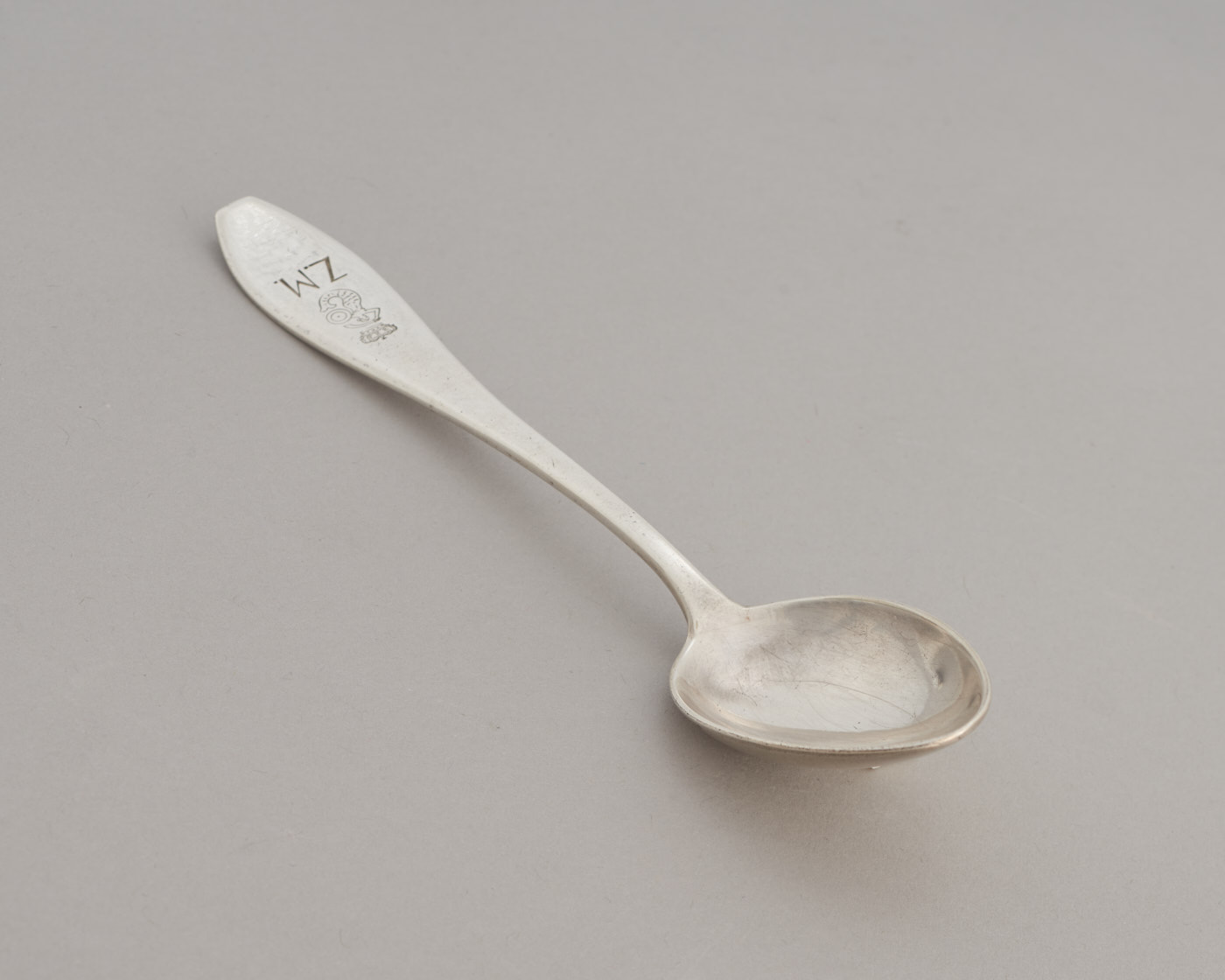
Teaspoon with a mermaid and a monogram Z.M.
after 31 January 1938
Hennberg Brothers Factory
14,5 cm
plated on white metal
MHW 24960/1-11
phot. A. Czechowski, M. MatyjaszewskiThis and 10 other spoons from the set (along with the handle and a fragment of the parquet from the City Council room) are among the few artifacts that survived from the interior of the former town hall, destroyed during the uprising in 1944. The spoons are part of a larger set of cutlery from the Warsaw City Hall at Plac Teatralny, which, until 1944, was the seat of the City Council (in Polish, “Zarząd Miejski”, hence the designation – “Z.M.”). The teaspoons were given to the Museum’s collection by the son of Stanisław Stawski- the city hall janitor.
-
3. Descent into the sewers - sculpture
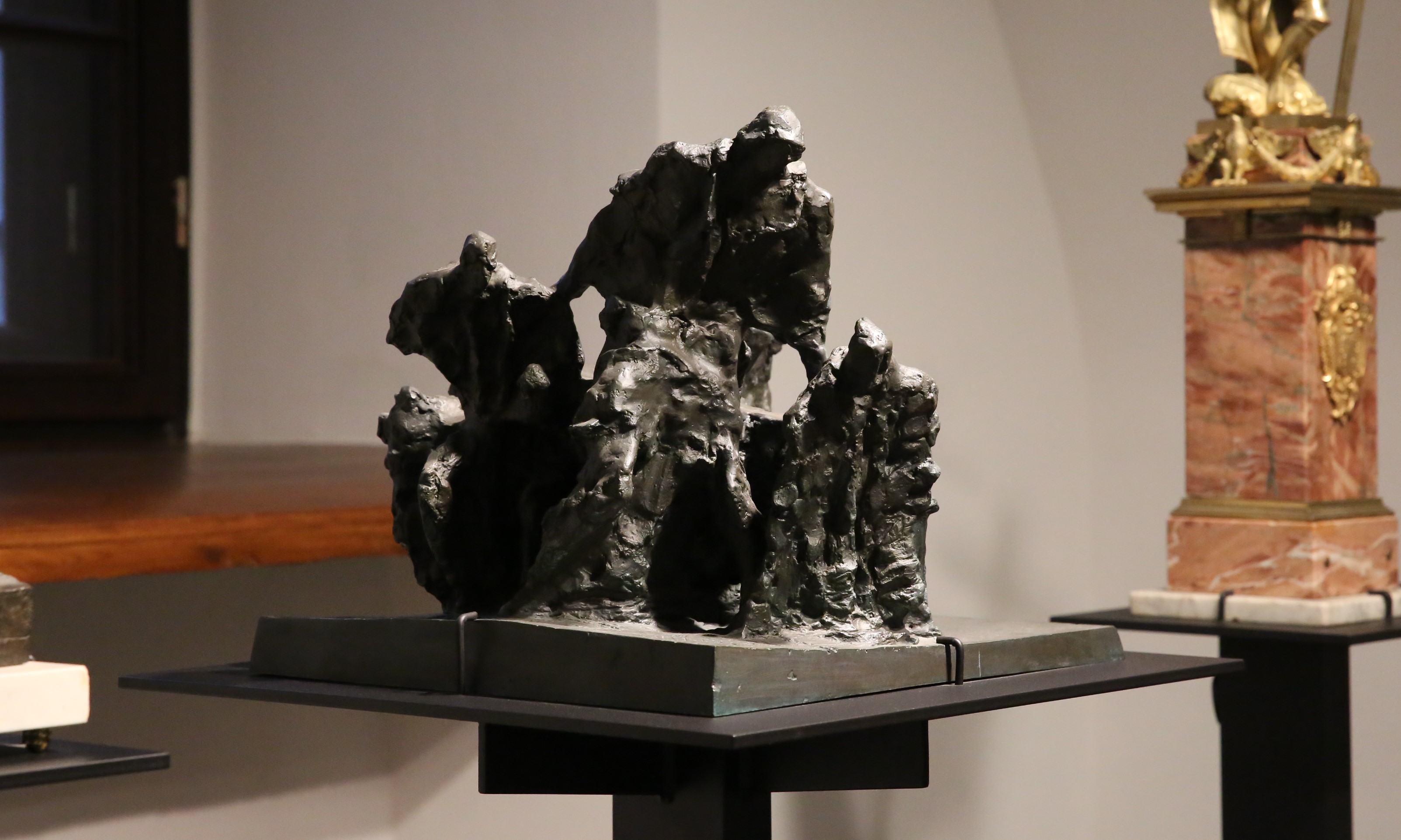
Descent into the sewers
1986
Wincenty Kućma
37 cm
cast, bronze
MHW 29230Descent into the sewers is a concept of one of the parts of the Monument of the Heroes of the Warsaw Uprising.
It presents a group of insurgents descending to the sewers, next to a standing priest. The idea of building a monument was born in 1980. The monument was created in an atmosphere of disputes, protests and announcing opposing competitions. The project of the sculptor Wincenty Kućma and the architect Jacek Budyn from Krakow – elected in 1985 – consists of two parts: a group of insurgents entering the channel and a group running out from under a falling pylon. Art critics disapproved of the work for its illustrative literalness. It was called a monument of defeat, not heroism. After subsequent changes, the monument was finally completed, satisfying neither the creators nor the public. It was unveiled on 1 August 1989, on the 45th anniversary of the uprising outbreak.
-
4. Monument to the Victims of the Wola Massacre
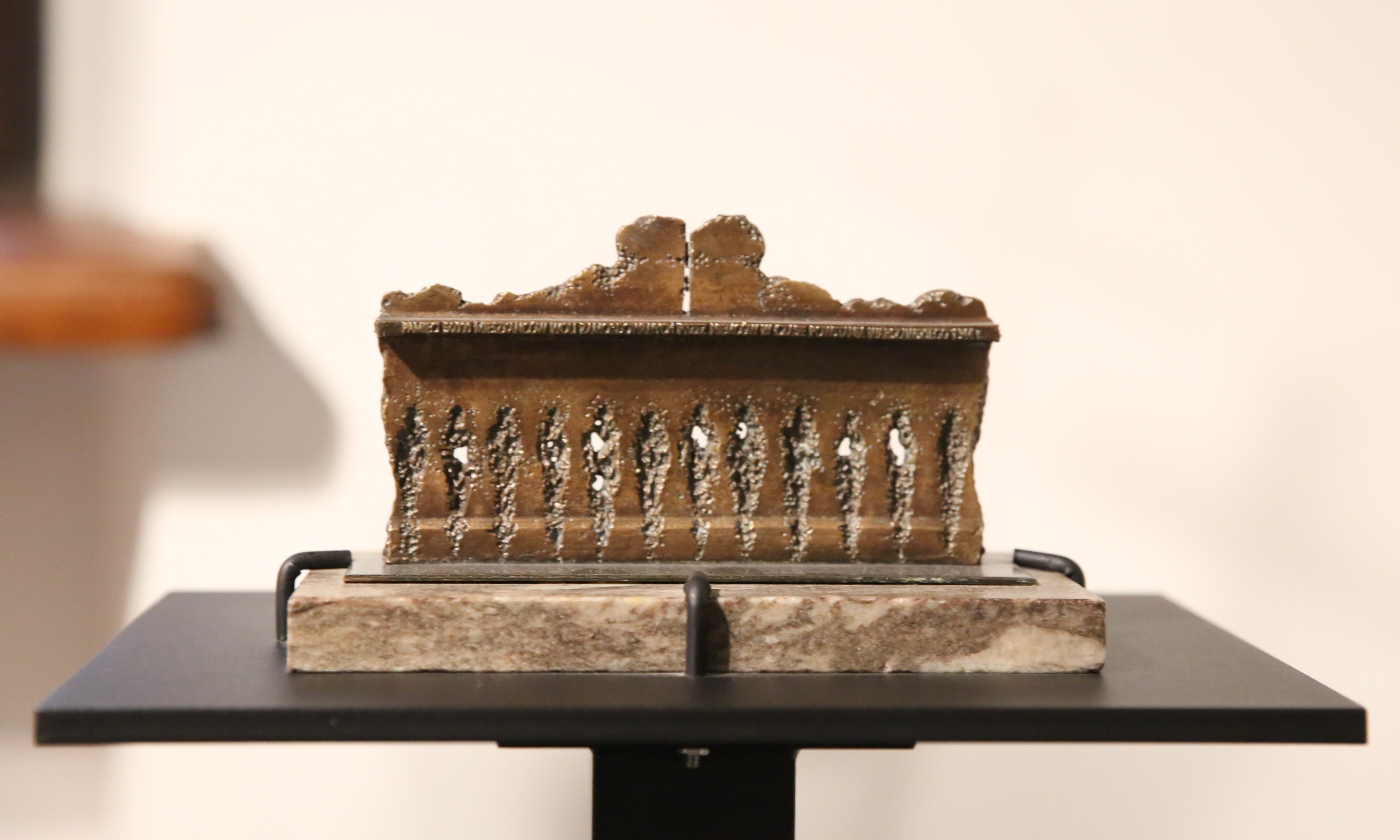
Monument to the Victims of the Wola Massacre. A miniature of the monument dedicated to the memory of 50,000 residents of Wola murdered by Germans during the Warsaw Uprising
2004
Ryszard Stryjecki
11 × 20 × 11 cm
bronze, marble
MHW 29480The original “Victims of the Wola Massacre” monument is located in a small square (“Skwer Pamięci”) at the intersection of Solidarity Avenue (Aleja Solidarności) and Leszno Street in Wola. The monument memorializes the mass-murder of the civilian population of the Warsaw district, carried out by Germans on 5-7 August 1944, during which about 50,000 citizens died.
The monument was designed and created by the sculptor Ryszard Stryjecki (born 1937) for the 60th anniversary of the Warsaw Uprising. He gave it the form of a jagged, rectangular wall of granite block topped with a cornice, which evokes associations of a ruined fragment of a building. There is an inscription which reads, “In remembrance of 50,000 inhabitants of Wola murdered by the Germans during the Warsaw Uprising in 1944”. Below the inscription were carved the silhouettes of 10 people, symbolizing the victims of the massacre. On the other side of the granite plate, among the bullet holes, there is a list of streets with the corresponding number of murdered inhabitants.
-
5. Head of a crying putto from the tomb

Head of a crying putto from the tomb of Marie Josephine Sobieska from church of the Sisters of the Holy Sacrament
1761
Johann Chrysostomus (?) Redler
22 × 33 cm
white marble
MHW 25471
phot. A. Czechowski, I. OleśOn 31 August bombs were dropped at the New Town district. One of them broke through the vault of the temple of the Sisters of the Holy Sacrament and buried underneath the rubble those who were seeking refuge inside. That day destroyed was one of its most precious monuments – the tomb of Marie Josephine Sobieska née Wessel (1685–1761), wife of Konstanty Sobieski (1680-1726), son of King John III Sobieski (1629-1696, King of Poland 1674-1696). The head of a putto, the part of this tomb, was found in 2000, when it was donated to the Museum by a private person.
In 1708, Konstanty Sobieski married Marie Josephine in Gdańsk, a fact he kept secret from his family. After merely several weeks of marital life, he abandoned his spouse and made efforts to seek an annulment of their marriage. The lawsuit lasted for many years and ultimately resulted in a reconciliation between the two. However, only one year later, in 1726, Konstanty passed away. As widow, Marie governed the Sobieski estate which she inherited from her husband.Towards the end of her life, she sold the land to her nephew Teodor Wessel and settled down in the convent of the Sisters of the Holy Sacrament in Warsaw, where she passed away in 1761.
-
6. A bullet above Solec III. Uprising on fire
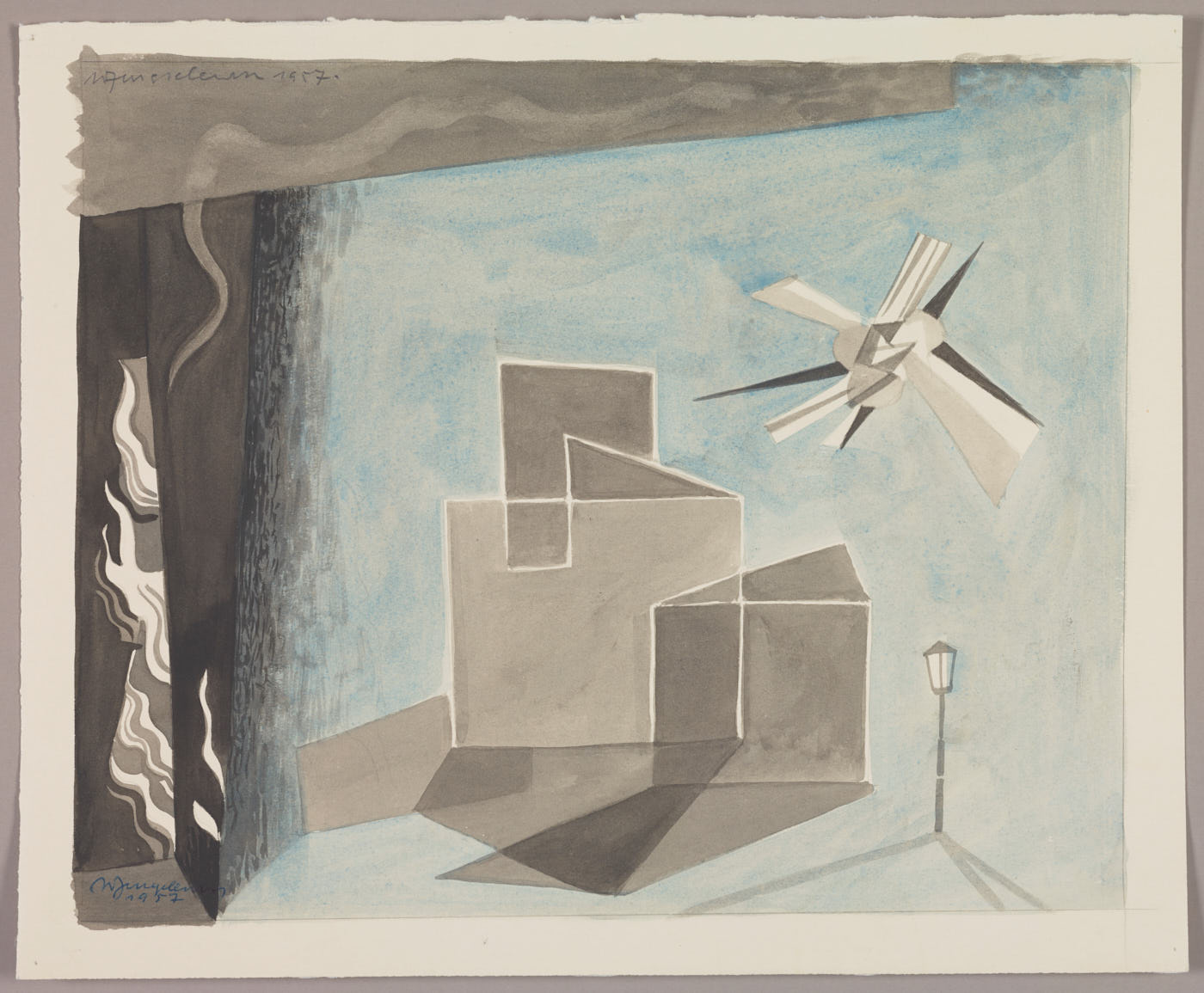
A bullet above Solec III. Uprising on fire
1957
Mieczysław Jurgielewicz
26 × 31,7 cm
paper on passe-partout, watercolor
MHW 22810This watercolor by Mieczysław Jurgielewicz, aka “Narbut”, is an artistic interpretation of the events of the Warsaw Uprising of 1944. The cubist composition may be associated with a theatrical decoration: in the center geometric shapes (buildings?), above them, on the right – a polygonal form (projectile?). At the bottom right, the only realistic element, a street lamp. On the left, close to the edge – flames and smoke protruding from behind the “wall”.
Mieczysław Jurgielewicz (1900-1983) was a Warsaw painter and a graphic artist. He studied at the Warsaw Academy of Fine Arts under the supervision of Władysława Skoczylas and Mieczysław Kotarbiński. He was a co-designer of the famous poster “To arms, in the ranks of AK” (Pol. AK-Armia Krajowa; Eng. Home Army), created with Edmund Burke on behalf of the 4th Press and Publishing Department of the Information and Propaganda Office of the Home Army. In German captivity he continued his artistic activity. He designed, among other things, the stamps of the camp mail.
-
7. View of Krakowskie Przedmieście
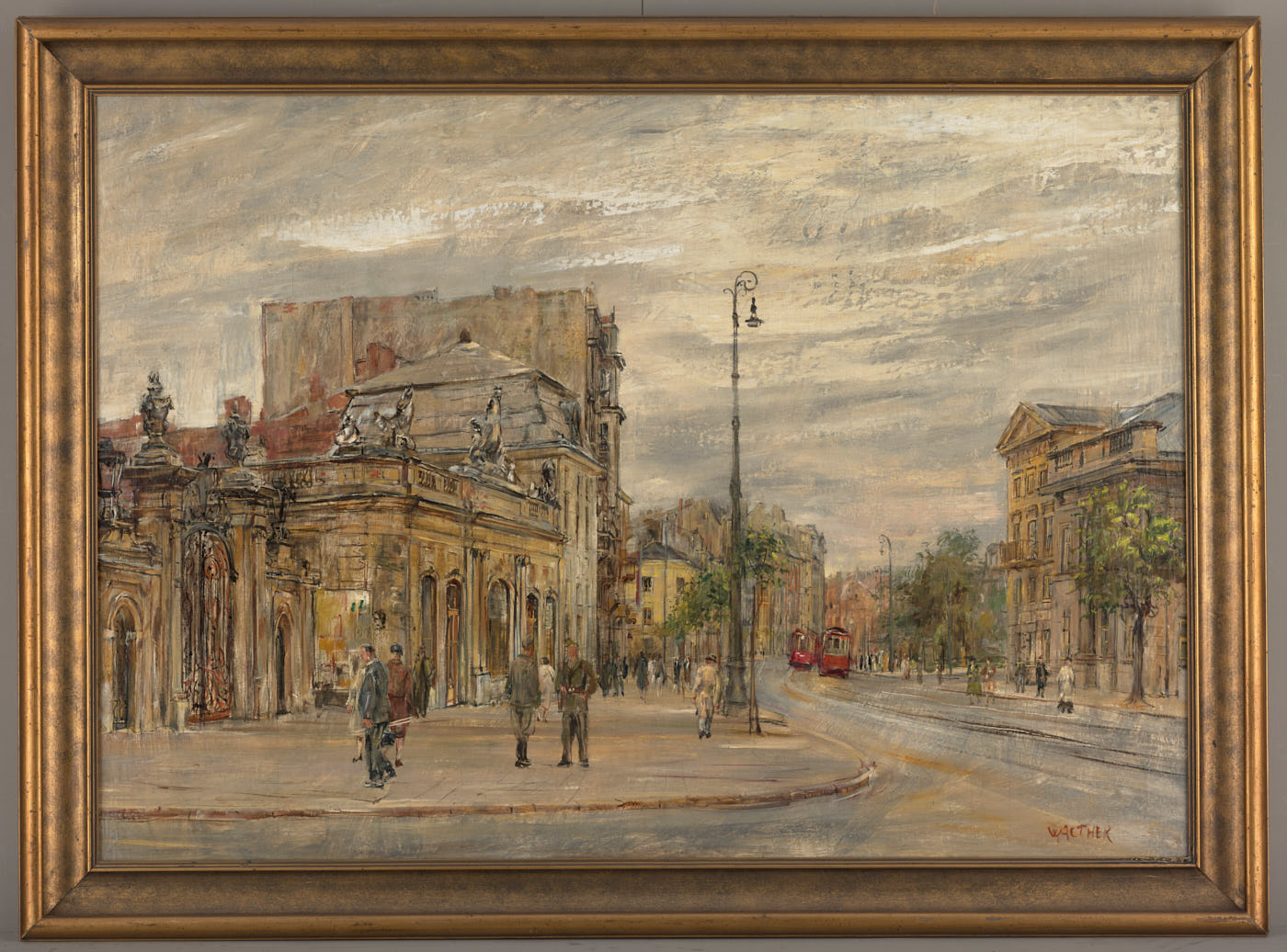
View of Krakowskie Przedmieście
1944
Karl Walther
65 × 92 cm
oil on canvas
MHW 28792Painted in the Impressionist style, the picture shows a view of Krakowskie Przedmieście from the European Hotel at the end of July 1944. On the left, you can recognize the gate of Potocki Palace, on the right – a fragment of the wing of Radziwiłł Palace and the outbuilding of the Carmelite monastery, which is today a part of the Presidential Palace.
The urban landscape represents a completely ordinary scene – two red trams travel along the street, and passersby are visible on the sidewalk, including two German soldiers. The mood of calm, normal life does not foretell the dramatic events that were soon to take place in Warsaw. This is probably one of the last views painted in Warsaw before the outbreak of the Uprising.
Karl Walther was a German painter, representative of the Post-Impressionist movement. Although he did not create art typical of the Third Reich, his works enjoyed popularity. A few of Walther’s paintings were in the private collection of Adolf Hitler. In 1944, the artist received a commission from the German authorities for landscapes of Gdańsk, Malbork, Warsaw and Kraków. On 1 August 1944, he was drafted into the army and sent to Italy.
-
8. Portrait of August Agbola O’Brown, aka Ali

From series „Ali”
Warsaw 2015
Karol Radziszewski
100 × 100 cm
acrylic paint on canvas
MHW 29854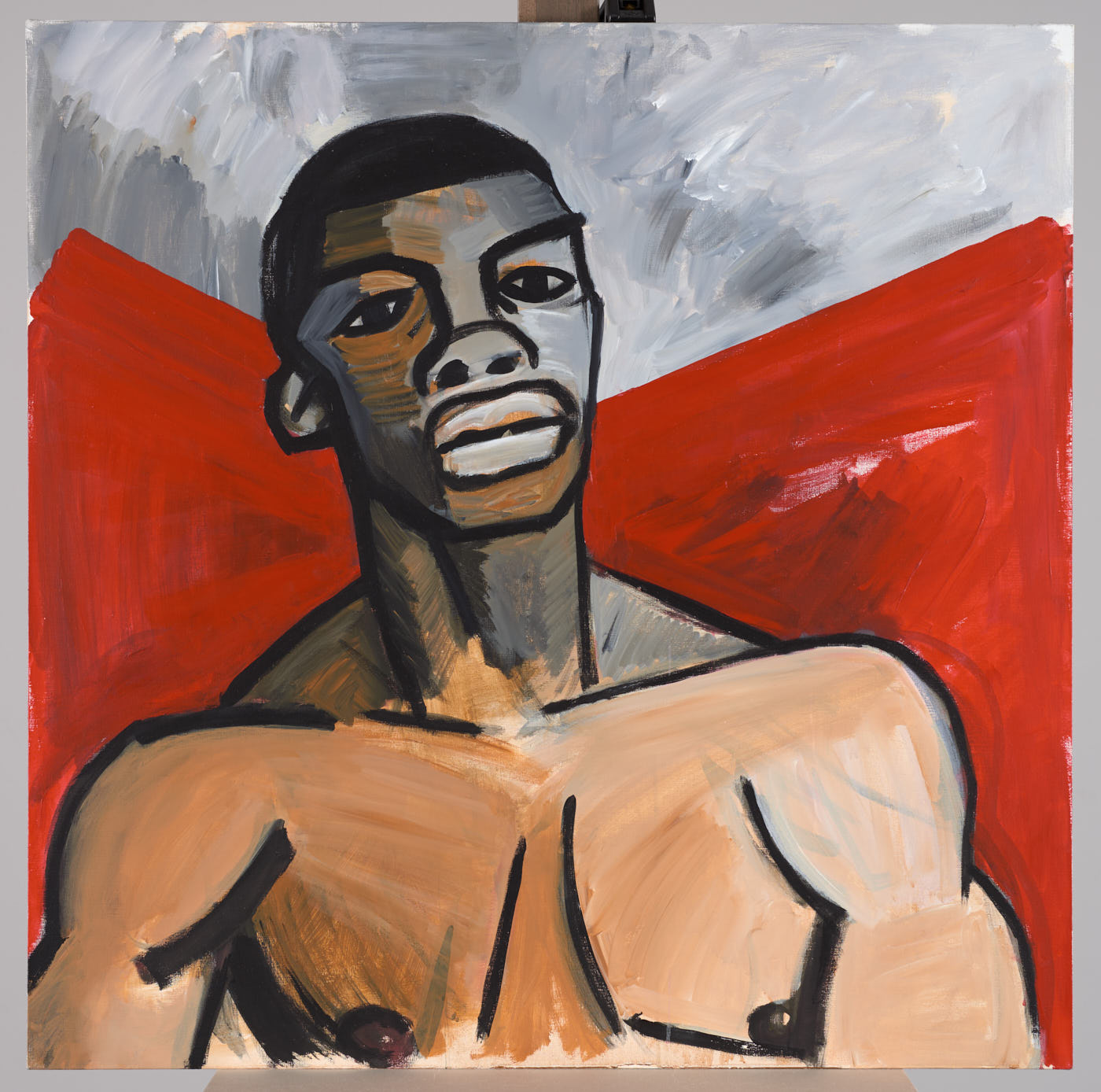
Portrait of August Agbola O’Brown, aka Ali (1895-1976), participant of the Warsaw Uprising
Warsaw 2015
Karol Radziszewski
100 × 100 CM
acrylic paint on canvas
MHW 29447The figure portrayed by Karol Radziszewski (b. 1980) is August Agbola O’Brown (1895–1976), a jazz musician born in today’s Nigeria, whose territories were colonised by the British at the time. O’Brown formed part of the history of Warsaw not only as a talented musician, but, above all, as a participant of the Warsaw Uprising of 1944, which was an armed insurrection against the German army that occupied Warsaw during World War II, a fact that Radziszewski highlights in his paintings.
He arrived in Warsaw in 1922, after staying in London and the Free City of Danzig where he had played drums in the local clubs. O’Brown settled down in Warsaw and started a family; his son Ryszard was born in 1928, followed one year later by another son Aleksander.
The work belongs to the series titled Ali in which the artist refers to the Cubist aesthetics of Pablo Picasso’s paintings in order to emphasise the fascination with African culture in European art and popular culture at the beginning of the 20th century. Thus, the artist evokes the historical and cultural context in which O’Brown appeared in the capital of Poland.
Radziszewski presented him in an insurgent uniform with a weapon against the backdrop of red and dirty ashen white, making an ambiguous reference to the Polish national colours, and thereby to the problematic of patriotic struggles. “Ali” took part in the Defensive War in 1939, and in 1944 he became a soldier of the Warsaw Uprising, fighting in the “Iwo” battalion in the southern part of the city centre in the area of the streets: Wspólna, Wilcza and Marszałkowska. He survived the Uprising and left Warsaw in unknown circumstances. He was never imprisoned in a POW camp and returned to the capital city shortly after the war. O’Brown worked for a certain period at the Culture and Art Department of the Municipal Office in Warsaw; he also found employment as a musician at different venues.
In 1958, as a British citizen, he emigrated to Great Britain. O’Brown’s story is situated on the margin of the 1944 Warsaw Uprising’s mainstream narrative. He does not belong to the circle of most prominent heroes whose names inhabit the collective historical consciousness. Radziszewski discovered his biography while exploring the sources for his work on a series of insurgent portraits, which were to form a mural for the Warsaw Rising Museum. He reclaimed Ali’s history, referring to the canon of representations of heroes and, at the same time, to the style of paintings by the 20th century most outstanding artists of the 20th century, who visited Warsaw in 1948.
The image of “Ali” in the Room of Portraits can be understood not only as an attempt to bring back to memory yet another participant of the struggle for liberation. O’Brown is also one of “Varsovians by choice”, a newcomer who developed a strong identification with the city and was prepared to risk his life in its defence.
-
9. Hope – Warsaw Uprising
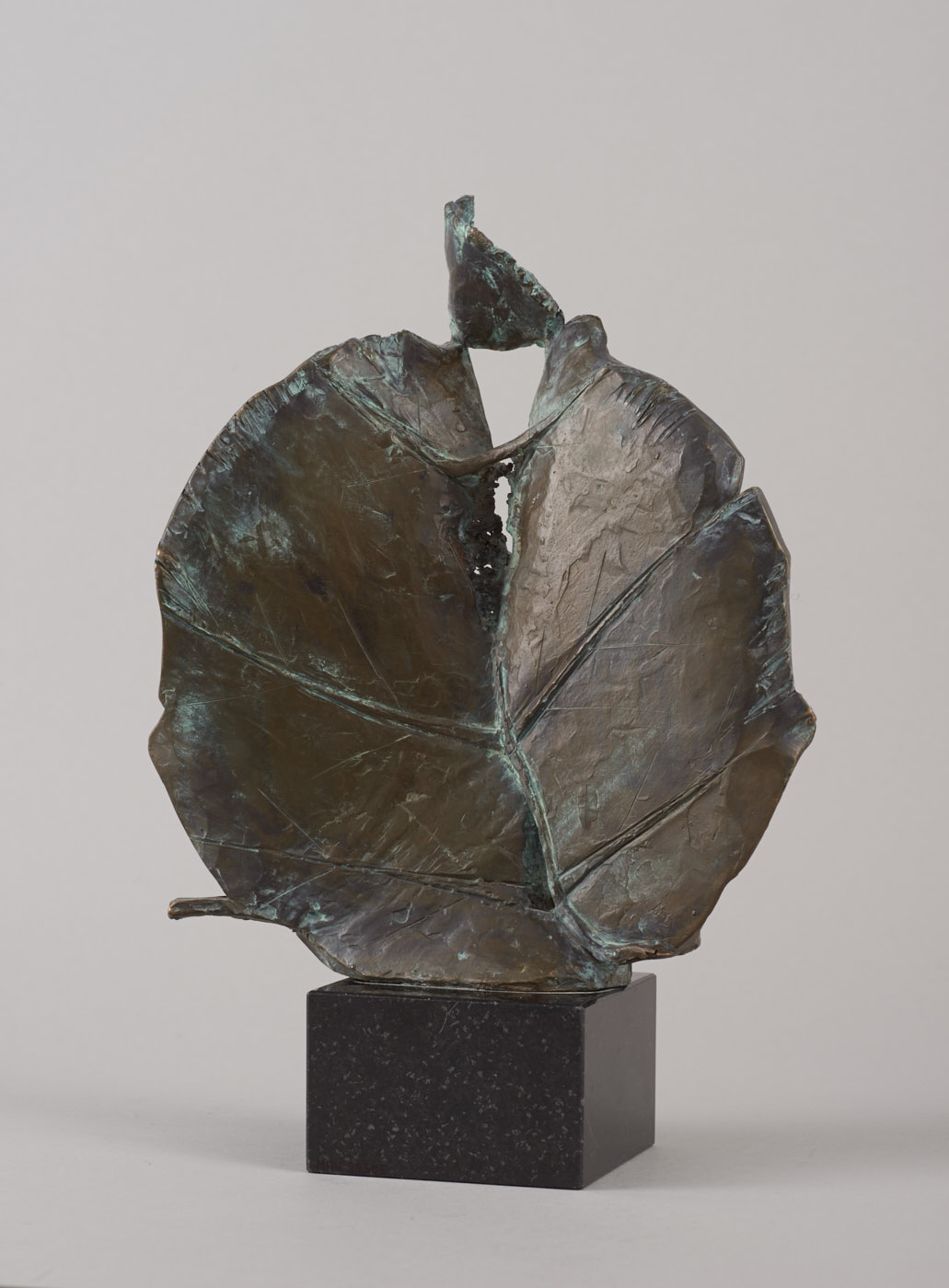
Hope – Warsaw Uprising | front
2013
Anna Beata Wątróbska-Wdowiarska, Marek Żebrowski
28 × 20 cm
bronze, granite, casting and patination
MHW 29305
phot. I. Oleś
Hope – Warsaw Uprising | back
This sculpture in the form of a medal placed on a granite pedestal was made for the exhibition Varsovia semper invicta. Memory and hope, organized in 2014 to commemorate the 70th anniversary of the outbreak of the Warsaw Uprising by the Warsaw District of the Association of Polish Artists. It has the shape of a cracked leaf which symbolizes life and hope, but which also resembles a broken heart. Crowded human figures on the obverse are Varsovians expelled from the destroyed city. The young leaf visible in the crack promises new life, rebirth. A part of the surface was covered with a pleasant, green patina.
Anna Beata Wątróbska-Wdowiarska is one of the Poland’s leading medal artists. She was born and works in Warsaw. Her artistic output includes coins, beaten and cast medals, and spatial sculptural realizations from a small forms to monuments. Her works are in museums and private collections all over the world. A number are also owned by the Museum of Warsaw, in which an exhibition of the artist’s works took place in 2000. Six years later, according to her project, the Museum launched a jubilee medal for the 70th anniversary of its existence.
-
10. Plaque Warsaw Uprising, 1 VIII 1944

Plaque – Warsaw Uprising, 1 VIII 1944
between 1944–1947
designed by Zygmunt Bieniulis, sculpture; foundry plant of Władysław Miecznik
20 × 16,9 cm
cast, patinated bronze, polished
MHW 43/JM
phot. A. Czechowski, I. OleśThe plaque presents a scene from the Warsaw Uprising. Behind the figures of the insurgents – one kneeling, the other struck in the chest – you can see the fighting Warsaw Mermaid. The plaque has been designed as a gift – that’s why there is an empty space under the stage for an engraving selected for the situation.
Zygmunt Bieniulis (1895-1963) was a sculptor, painter, and graphic artist. He studied at the School of Arts and Crafts and Applied Arts in Warsaw.
The foundry plant of Władysław Miecznik was one of the most important artistic craft factories in post-war Warsaw. He offered a wide range of products made of bronze and other metals.
-
11. Miniature of Nike sculpture

Nike
before 1960
Karol Tchorek
50 × ok. 25 cm
cast, patinated bronze
MHW 23784
phot. A. Czechowski, I. OleśThe massive Nike figure supports a lump imitating fire on which is visible the sign of Fighting Poland (Polska Walcząca PW). This is a miniature of the monument from Ostrowia Mazowiecka, commonly known as “Ostrowska Nike”. The creator of the sculpture is Karol Tchorek. His designs are widely known in Warsaw, though not necessarily associated with his name – Tchorek is the creator of the plaques commemorating the places of struggle and martyrdom at the II World War in Warsaw. Although up to the 1960s there were even several hundred tables designed by Tchorek, currently their number is estimated at around 150.
-
12. Blouse of a participant of the Warsaw Uprising

A blouse of the participant of the Warsaw Uprising Janina Rucińska-Kazimierska, aka „Kalina II”
Warsaw, July 1944
tailor Helena Pruszyńska
silk (parachute fabric, metal latches), technique: hand and machine sewing
61 × 35 cm (width at the arms)
MHW 26227
phot. A. Czechowski, M. MatyjaszewskiA blouse which belonged to the uprising participant, Janina Rucińska-Kazimierska, aka “Kalina II”, made of pale matte green silk – a fabric obtained from parachutes used by the Allies to drop supplies for the Armia Krajowa (Home Army).
A tailor, Helena Pruszyńska, sewed her clothes in preparation for the coming dangers – the stronger fabric was supposed to have greater durability. Trouble finding materials, caused by the war, forced Warsaw residents to be inventive and use all available fabrics. The blouse has long sleeves, a collar and yoke; the front is decorated with ruffles and fastened with small buttons covered with the same material and loops made by hand with threads.
-
13. Design of a commemorative medallion containing a lump of rubble
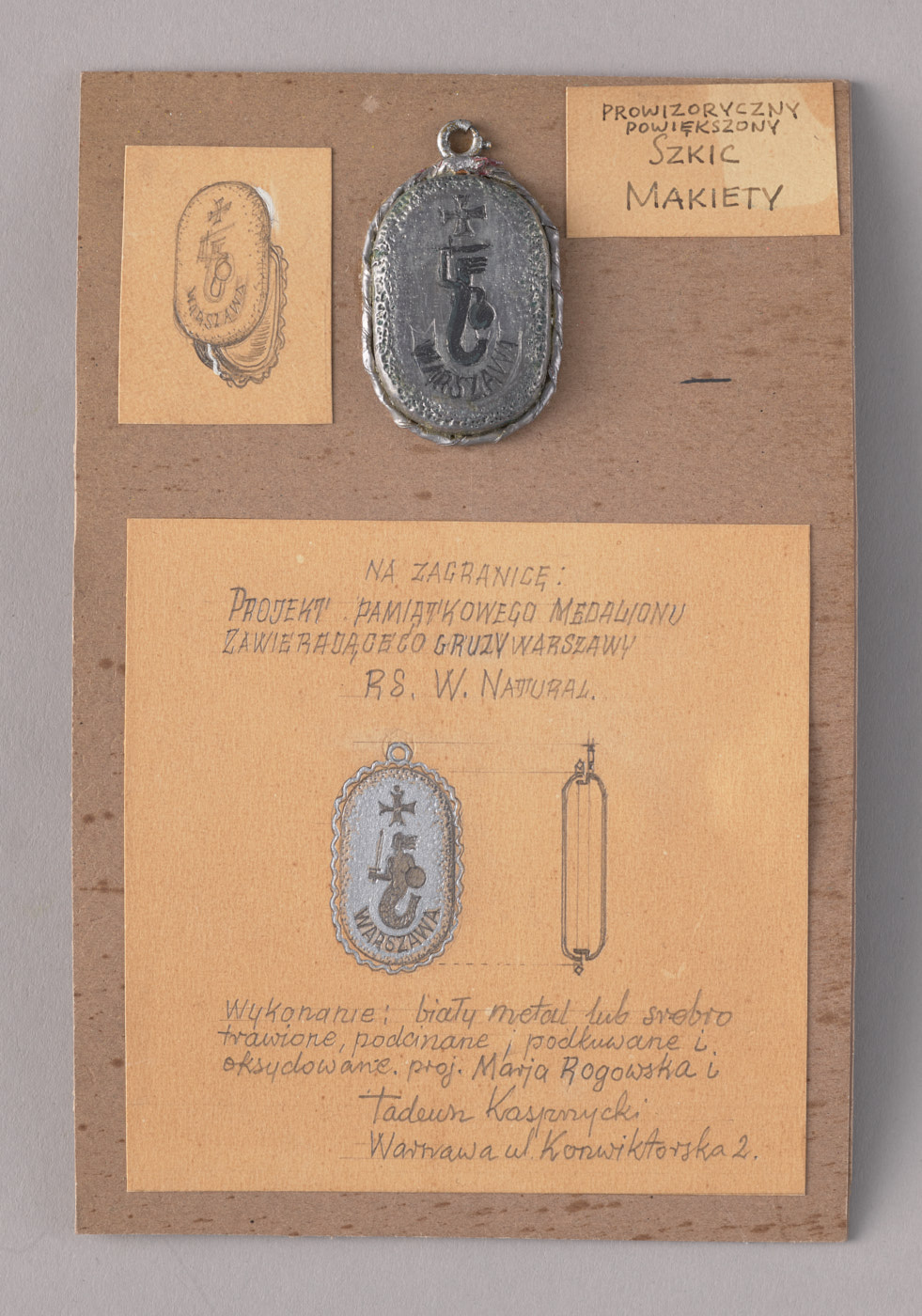
Design of a commemorative medallion containing a lump of rubble from Warsaw destroyed after the World War II
1947–1952
Stanisław Kurman
20 × 13,5 cm (all); 5,5 × 3,5 cm (medallion)
cardboard, aluminum sheet
MHW 25923
phot. M. Matyjaszewski, A. NiakrasauThe unrealized project of a two-sided, probably opened medallion was created by the Warsaw artist Stanisław Kurman. In the middle of the medallion was a clod of rubble from Warsaw after World War II. On the medallion there are the Virtuti Militari Order, the Warsaw Mermaid and the inscription “Warszawa”.
The highest military decoration “in recognition of the heroic, persistent bravery proven by the population of the capital city of Warsaw in defense against the German invasion,” awarded to the city on 9 November 1939 the Prime Minister, Supreme Commander, Major General Władysław Sikorski. A commemorative medallion meant to be distributed among Polish emigrants.
-
14. Plaque from the Central Insurgent Hospital No. 1 at 7 Długa Street

Plaque from the Central Insurgent Hospital no 1 at 7 Długa Street
1934, inscriptions from 1945
60,5 × 20 cm
marble, gilding, pencil
MHW 15702
phot. M. Matyjaszewski, I. OleśThe plaque with the inscription “ZBUDOWANO MDCCIV” (“BUILT MDCCIV”) comes from the Raczyński Palace at 7 Długa Street. Before the war, the palace served as the Ministry of Justice, and in August 1944 – as the Central Insurgent Hospital No. 1. At the beginning of September 1944, the seriously wounded from other hospitals who were unfit for transport to Śródmieście were grouped there. After the hospital was occupied, the Germans killed about 430 seriously injured people and burned their bodies.
The marble was covered with handwritten inscriptions from people seeking or having information about insurgents staying in the hospital- about what happened after leaving the hospital or the circumstances of death of former patients.
-
15. Monkey „PM-ek”
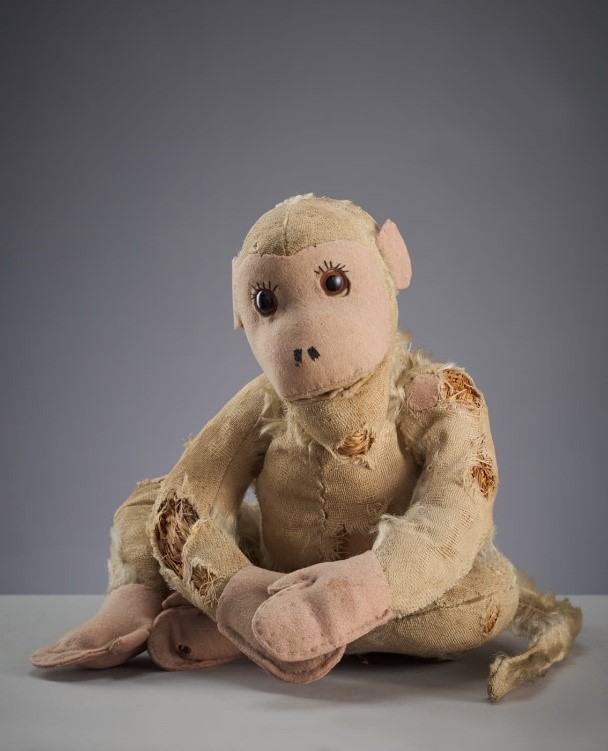
Monkey „PM-ek”
before 1939
unknown workshop
22 cm
flax, felt, plastic, wire, sawdust, glass, machine and manual sewing
MHW 30681
phot. A. CzechowskiMonkey „PM-ek” („Peemek”) is a mascot that has an amazing story behind it. Wanda Traczyk-Stawska aka “Pączek” got a “Peemek” monkey as a consolation in exchange for surrendering after the capitulation of the Warsaw Uprising.
The mascot was found by soldiers of the Home Army in a child’s room in one of the demolished tenement houses in the Northern Śródmieście district at the end of the insurgent fights in September 1944. It got its name, Peemek, from the PM, which is an abbreviation for a pistolet maszynowy (Eng. machine gun). It accompanied the owner during the march to captivity, hiding her most precious trifles – wedding rings, watches, and medallions. It was also with her in the transit camp for prisoners of war in Ożarów, and then in the camps in Lamsdorf, Zeithain, Altenburg and Oberlangen. After being liberated by the army of General Stanisław Maczek, the monkey and its owner found themselves in Italy. Later, together with the army, they moved to Egypt and Palestine and in 1947 they both returned to Poland.
Wanda Traczyk-Stawska decided to give the monkey to the collection of the Warsaw Museum as a memento of the tragic days of the end of the Uprising and her stay in the prisoner-of-war camps. It is also one of the most personal souvenirs that accompanied its owner almost all her life.
-
16. White and red flag from the insurgent barricade on Długa Street in Warsaw
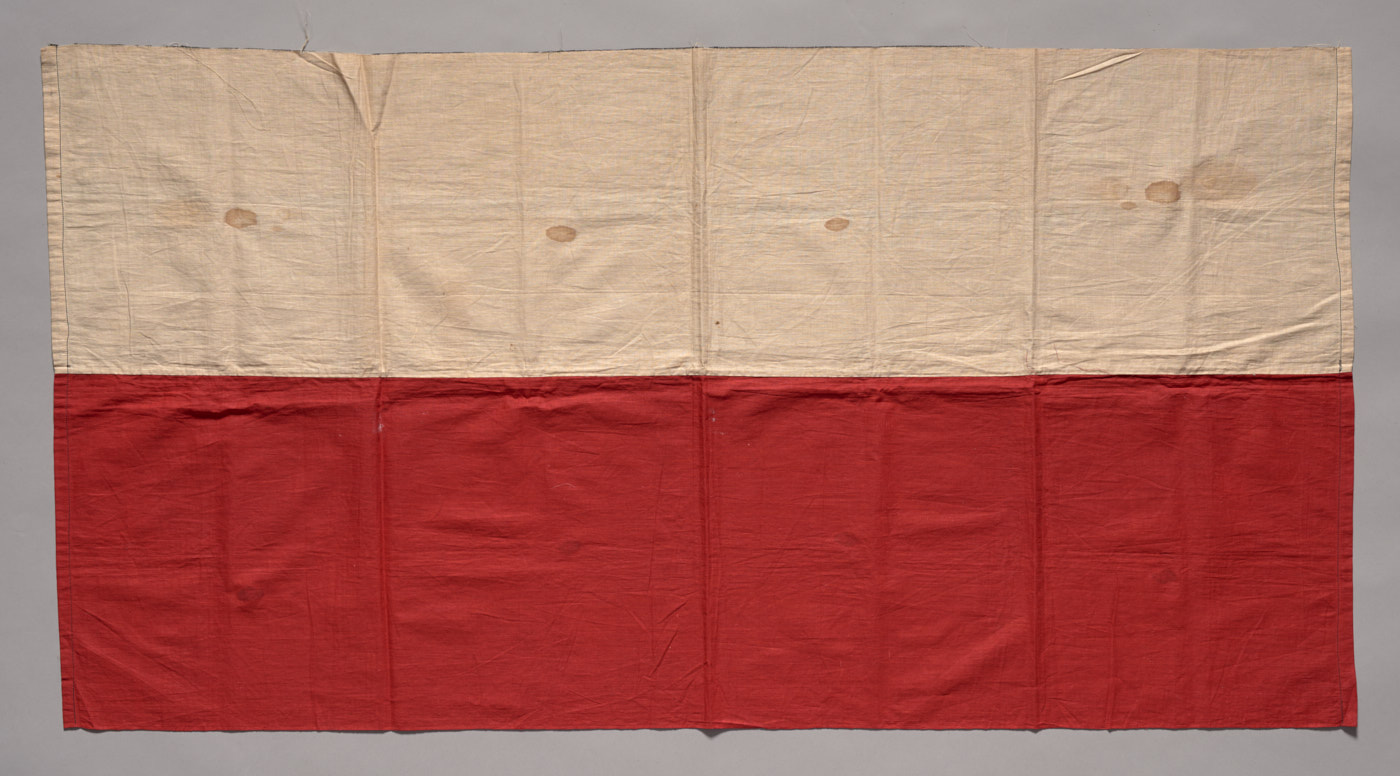
White and red flag from the insurgent barricade on Długa Street in Warsaw
August 1944
118 × 58 cm
canva, machine sewing
MHW 28789
phot. M. Matyjaszewski, A. NiakrasauThe insurgent flag was placed on the Polish barricade at the corner of Długa and Barokowa Streets. At the end of August 1944, it was removed and transferred by Zdzisław Skwara aka “Zych” through the sewers to the Northern Śródmieście district. Skwara kept the flag during his stay in a prisoner-of-war camp and after returning to Poland. The family donated the memorabilia to the Museum in 2013.
Zdzisław Skwara (1920-2009) was a corporal cadet of the 101st sapper company Home Army, “Gozdawa” grouping “Kuba” – “Sosna”.
-
17. Pocket watch, “onion”, of Wanda Ostoja-Chodkowska aka „Ancilla”
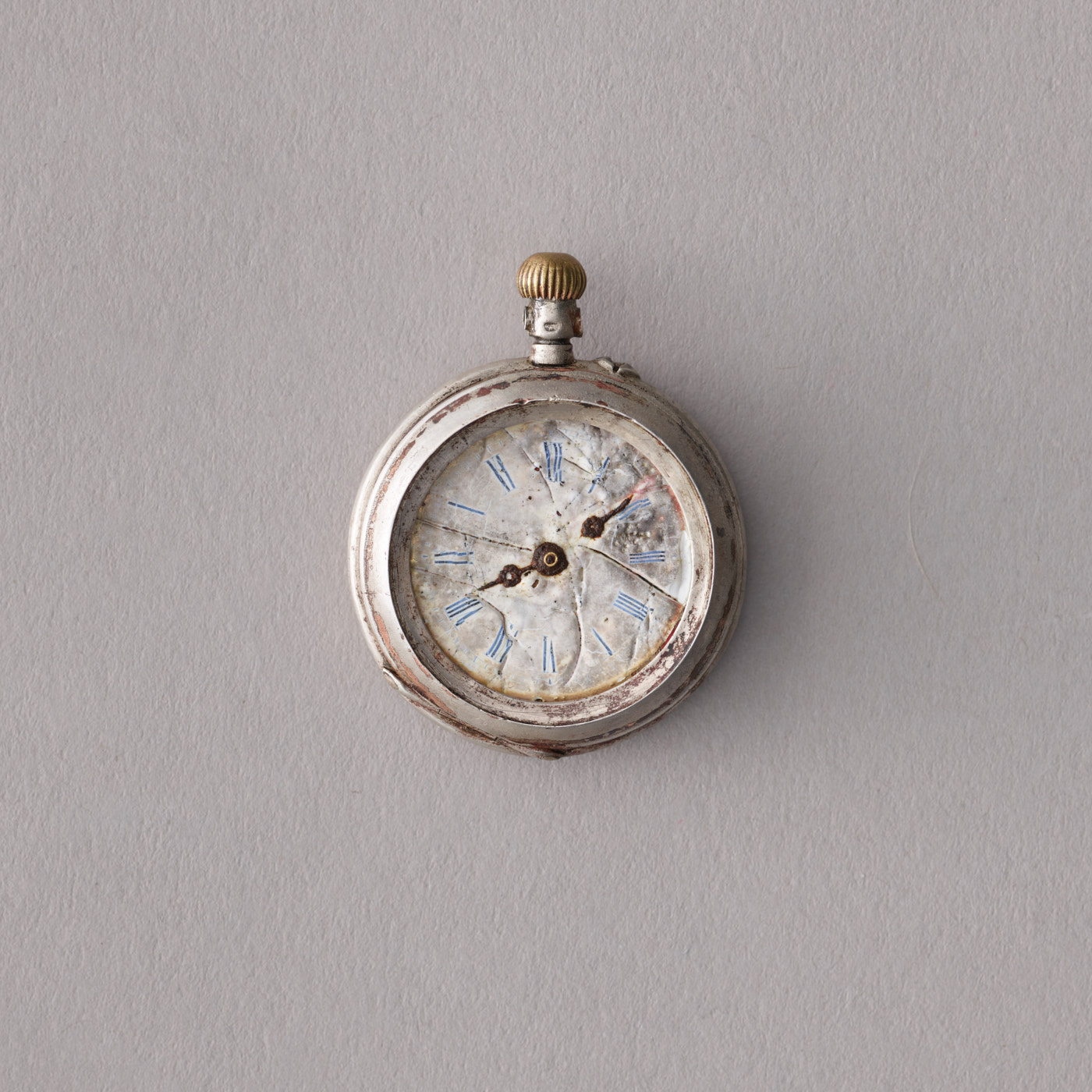
Pocket watch, “onion”, of Wanda Ostoja-Chodkowska aka „Ancilla”
diameter: 3 cm
metal, damaged
MHW 29220
phot. M. Matyjaszewski, A. NiakrasauThis destroyed watch belonged to Wanda Ostoja-Chodkowska aka “Ancilla” (1905-1944). She was a nun from The Congregation of Ursuline Sisters of the Agonizing Heart of Jesus and also, in conspiracy, a nurse at the WSK (Wojskowa Służba Kobiet, Eng. Women’s Army Service) of the Home Army in the Śródmieście district.
During the Warsaw Uprising, she began her service at the medical point at 1 Gęsta Street in the district of Powiśle. She died while helping on the first day of the uprising on 1 August 1944. She had this pocket watch with her when it stopped forever at 9 minutes after 8 o’clock. “Ancilla” was posthumously awarded with the Cross of Valour.
-
18. Glasses case with an image of Our Lady of Częstochowa
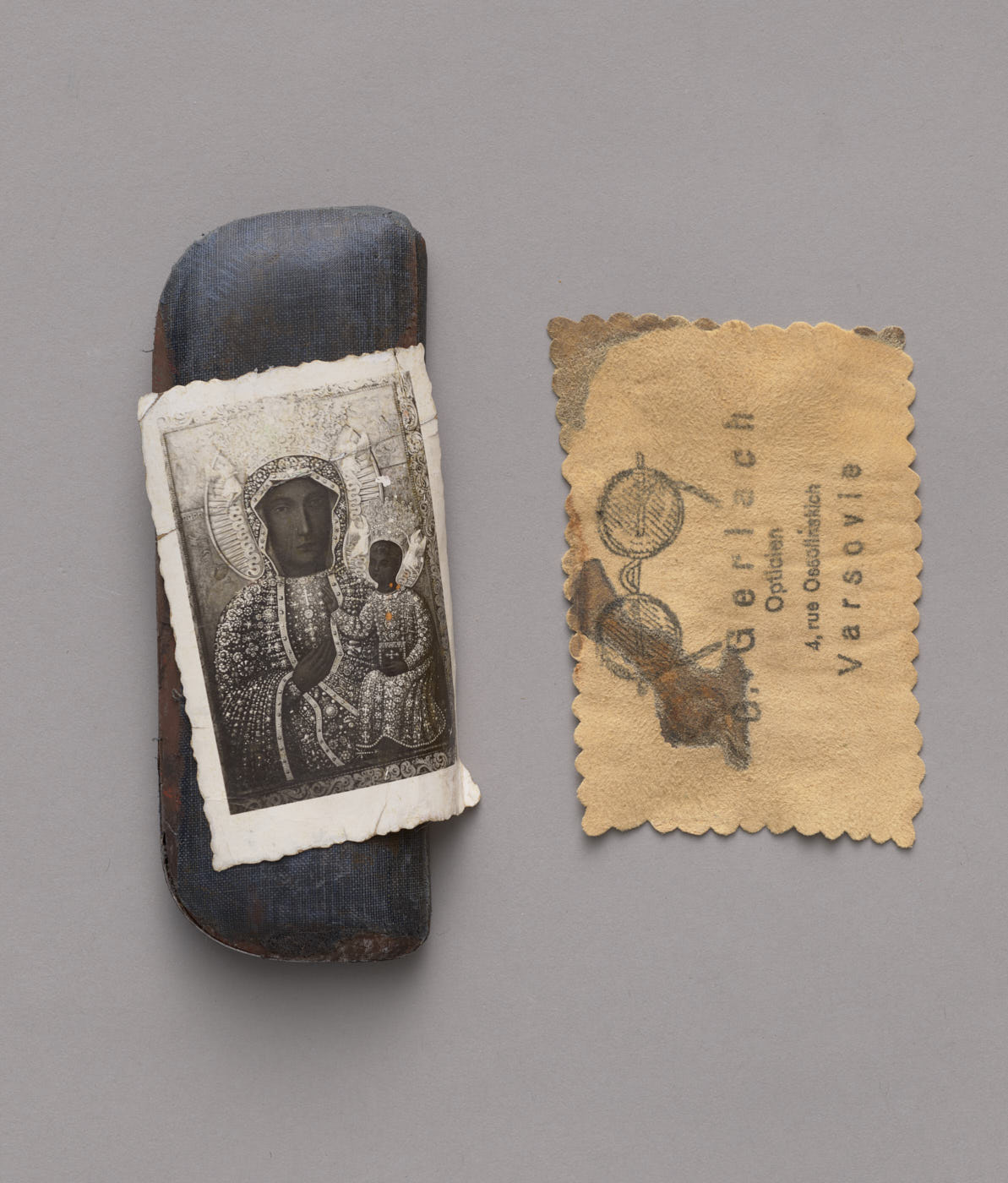
Glasses case with an image of Our Lady of Częstochowa
Gustaw Gerlach Factory
Warsaw, 1930s
metal, paper veneer, broadcloth, silk factory product
paper,print
14,8 × 5,5 × 1,5 cm
MHW 26638/1-2
phot. A. Czechowski, I. OleśThis glasses case was found next to 23-year-old Andrzej Wojno (1921-1944), insurgent and scout of the 16th Zawisza Czarny Warsaw Scouting Team. According to the family an image and a case were glued to each other by means of blood. The icon of Our Lady of Częstochowa has been the object of special cult among Poles since the end of the 14th century.
Wojno perished on 19 August 1944 in the Warsaw Uprising during defence of the edifice of the Warsaw University of Technology. He was buried on 21 August at 17 Śniadeckich Street, the location of a makeshift cemetery.
The insurgents and civilians who had lost their lives were temporarily buried in the streets, backyards and on the squares within city center. Corked bottles with information about the victims were left together with their bodies and personal items, unless they were given to their closest relatives and friends.
After the war – since the spring of 1945 until early 1950s – the Polish Red Cross carried out exhumations which were motivated by sanitary reasons, respect for the buried individuals, and the need to record losses incurred by the population of Warsaw.
That relic, as well as a wallet with a metal monogram, a wad of banknotes from period of the German occupation and a medallion with the Image of Virgin Mary, alongside photographs and documents, were donated to the Museum in 2006 by Andrzej Wojno’s closest family.
-
19. Exploding missile which hits the Prudential building
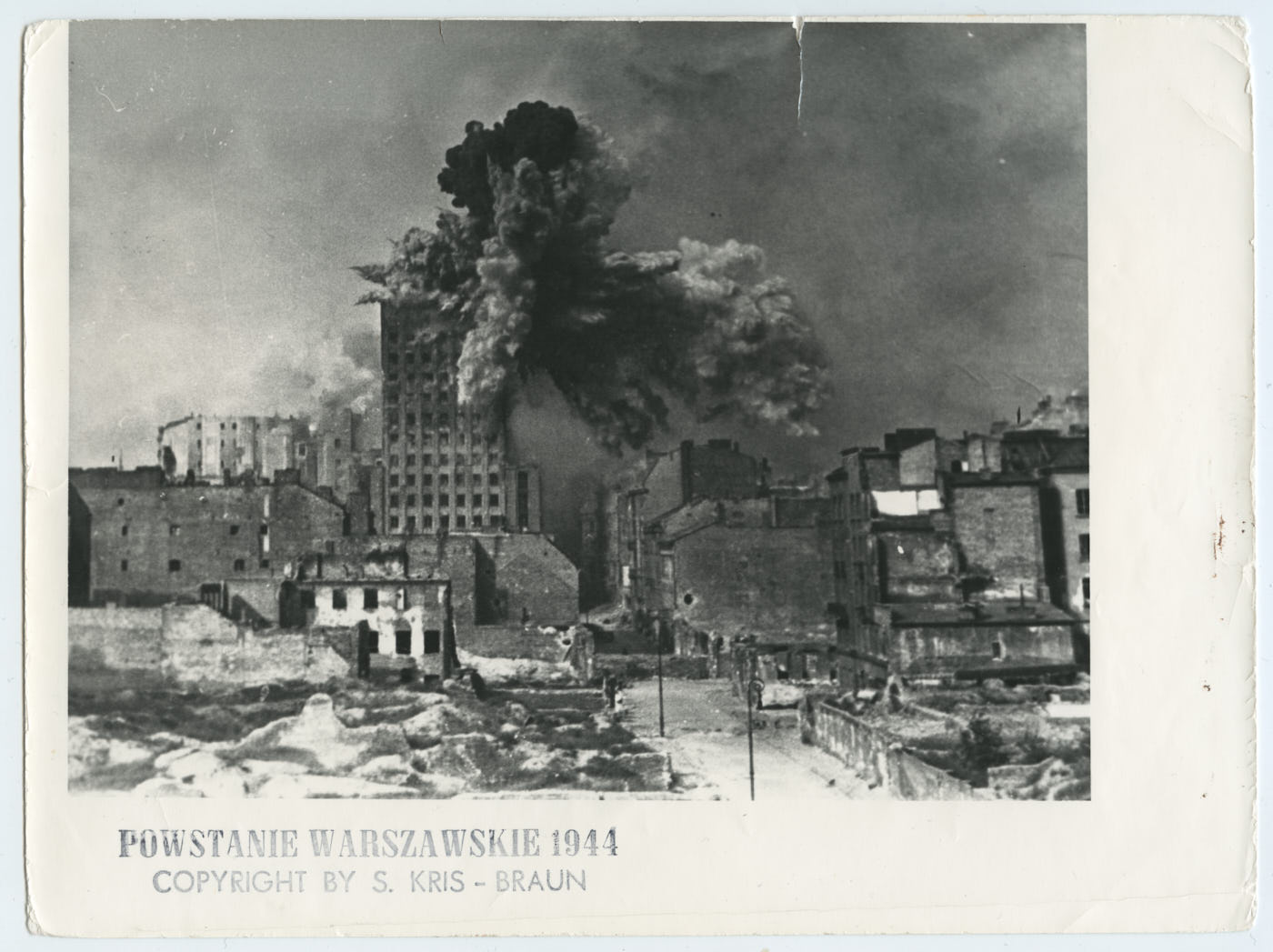
Exploding missile which hits the Prudential building during the Warsaw Uprising
Sylwester Braun, aka“Kris”
Warsaw; 28 August 1944; print 1981
photographic print
AN 49751/A
17,7 × 23,7 CMThe moment of explosion of a missile that on 28 August 1944 hit the most modern skyscraper in Warsaw at the time, the seat of the Prudential insurance company, was captured by Sylwester Braun (1909–1996), known under the Uprising code-name Kris, in six consecutive shots.
The presented black and white print inaugurates the sequence and shows the moment of explosion. It was created by the photographer from the original negative in 1981 in the United States, where Braun settled down after the war. It bears a characteristic stamp which reads Warsaw Uprising 1944 / Copyright by S. Kris – Braun. The Warsaw Uprising was an armed insurrection against the German army occupying Warsaw, organised by the conspiratorial armed forces. Sylwester Braun single-handedly created several sets of prints. In 1981, he donated one set alongside a set of original negatives to the Museum. Braun used the remaining sets in presentations, lectures and exhibitions which he organised for the Polish diaspora in America, primarily in California.
The sixteen-storey building, the highest in Warsaw at the time, was designed by Marcin Weinfeld (1884–1965), and erected in 1933. The modern steel and reinforced concrete structure was designed by Stefan Bryła (1886–1943) and Wenczesław Poniż (Slovenian: Venčeslav Poniž, 1900–1967). In 1936, Professor Janusz Groszkowski (1898–1984) launched the first transmitter of an experimental television station in Europe on the purpose-built mast on the roof of Prudential. The lower part of the skyscraper housed office spaces, whereas luxury apartments were located on the higher stories.
During the Warsaw Uprising, after the edifice was seized by insurgents in August 1944, the white and red flag was hung on the mast, and Prudential became a target of ongoing fire of the German artillery. Around thousand missiles were dropped in the vicinity of the building. The one visible in the photograph, which weighed nearly two tons and was fired from the heaviest self-propelled mortar, one of the seven such mortars used by the Germans during World War II (1939–1945), damaged the building, yet it did not destroy it. The modern welded structure endured the explosion.
The series of shots that document the consecutive phases of the explosion became an icon in the oeuvre of the photographer, who recalled: “Assuming that the Prudential edifice would become the target of German fire, a building whose upper storeys housed an insurgent observation point, I decided to check if my predictions were right. I ensconced myself on the roof of the house at 28 Kopernika Street. The weather was beautiful, clear morning sunshine, the panorama of wounded Warsaw close at hand. The ruins did not obstruct the view. Smoke from fires was visible in the distance. Time passed. I controlled my Leica once again – f/8, 1/200 sec, distance: infinity. (…) I had spent an hour waiting when I noticed the yellow trail of a missile against the backdrop of azure sky. In the viewfinder, I saw Prudential being hit and the explosion in bloom – over a period of three seconds I took six photographs.”
As a field war reporter of the Home Army Operational Command’s Office of Information and Propaganda, Braun produced approximately 3,000 negatives during the Warsaw Uprising.
